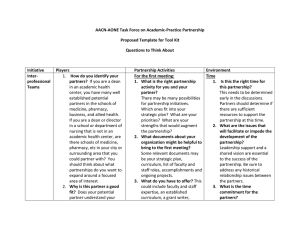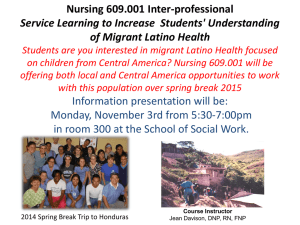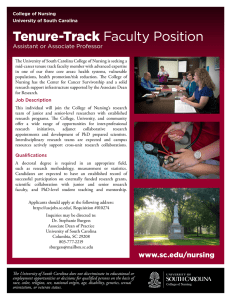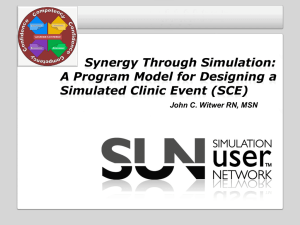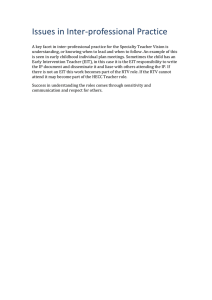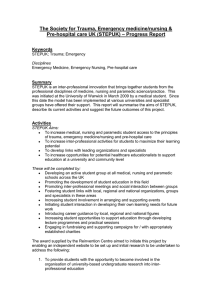AACN-AONE Task Force on Academic-Practice Partnership Proposed Template for Tool Kit
advertisement
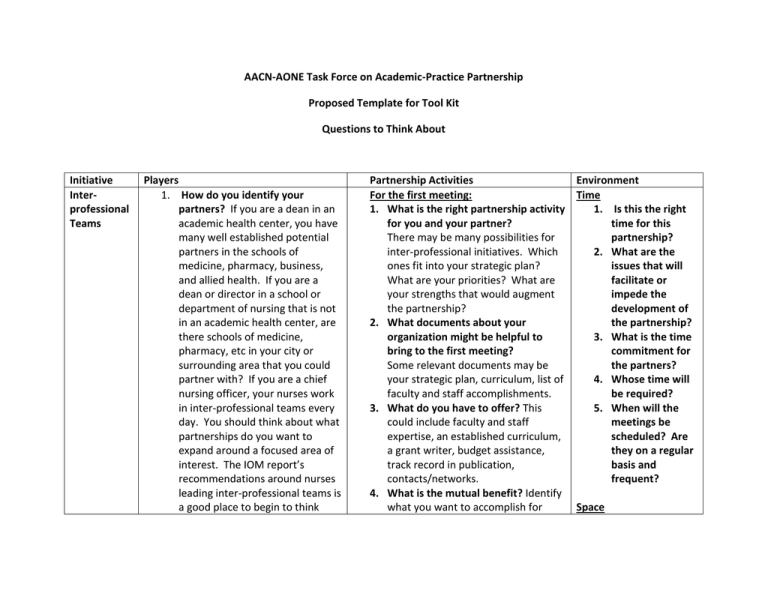
AACN-AONE Task Force on Academic-Practice Partnership Proposed Template for Tool Kit Questions to Think About Initiative Interprofessional Teams Players 1. How do you identify your partners? If you are a dean in an academic health center, you have many well established potential partners in the schools of medicine, pharmacy, business, and allied health. If you are a dean or director in a school or department of nursing that is not in an academic health center, are there schools of medicine, pharmacy, etc in your city or surrounding area that you could partner with? If you are a chief nursing officer, your nurses work in inter-professional teams every day. You should think about what partnerships do you want to expand around a focused area of interest. The IOM report’s recommendations around nurses leading inter-professional teams is a good place to begin to think Partnership Activities Environment For the first meeting: Time 1. What is the right partnership activity 1. Is this the right for you and your partner? time for this There may be many possibilities for partnership? inter-professional initiatives. Which 2. What are the ones fit into your strategic plan? issues that will What are your priorities? What are facilitate or your strengths that would augment impede the the partnership? development of 2. What documents about your the partnership? organization might be helpful to 3. What is the time bring to the first meeting? commitment for Some relevant documents may be the partners? your strategic plan, curriculum, list of 4. Whose time will faculty and staff accomplishments. be required? 3. What do you have to offer? This 5. When will the could include faculty and staff meetings be expertise, an established curriculum, scheduled? Are a grant writer, budget assistance, they on a regular track record in publication, basis and contacts/networks. frequent? 4. What is the mutual benefit? Identify what you want to accomplish for Space about potential new and/or refocused partnerships. 2. Why is this partner a good fit? Does your potential partner understand your programs, your goals, your vision? Do you have a common ground and shared vision? Is this partner approachable and available? Have you tried to reach out to this partner? 3. How do you approach your potential partner? How do you make the appointment with the right person? Who is the right person? The first step is finding out who the right contact person is. Use your networks to collect this information. Then, pick up the phone or send an email. Be clear on why you are contacting the potential partner. Use the IOM report and the following work to build a case for a partnership: The Interprofession Education Colaborative’s “ Core Competencies for Interprofessional Collaborative Practice,” The IOM Report on the Future of Nursing; “ The Health Professionals for a New Century” your strategic vision and what might 1. What space is be of benefit to the partner. This required for the could be joint programming, clinical activity? experiences, leadership 2. What equipment opportunities, professional or supplies are development, or a larger scale needed? organizational commitment. 3. What $ is 5. What is your vision? Be sure to needed? identify this before the first meeting 4. Where are we and be able to clearly communicate meeting? this. Does your potential partner 5. Where will we share this vision? Ask this question present directly. If the answer is no, address outcomes? related possibilities for partnership or decide that the partnership would Regulation: not be strategic at this time. 1. What are the 6. What is the potential policies or initiative/activity and who else regulatory issues needs to be involved in both that will impede organizations? Have some initial or facilitate ideas before the first meeting. Be development of prepared to brainstorm, prioritize, the partnership and compromise. on both sides? 7. Who is the top leadership in the organization? Are you talking to Context: them? Be sure to be talking to the 1. How will the person in the organization who is the partnership be decision maker. If at the first funded? meeting, you determine that the 2. What are the person with whom you are speaking constraints of is not the decision maker, ask for both partners? Report published in Lancet ( guidance on who this person may be. December 4, 2010, vol 376, pp. 8. What is the business case for the 1923-58. partnership? Once you decide 4. Where do you meet? Offer to together on the inter-professional host the first meeting… but initiative, together discuss the ROI. basically meet wherever is most Determine how much the initiative convenient for your potential will cost each organization and what partner. the return on investment is for each 5. Preparing for the first meeting: partner. Determine whether or not What do you need to know about there is financial value to each your potential partner and his or partner. If not… abort the plan and her organization? What does start over. your partner need to know about 9. What are the next steps? Do you you and your organization? Be have a timeline established at the sure to come prepared having end of the first meeting? read anything you can on your 10. Have you sent a thank you not with potential partner and organization next steps? to assess a fit for partnership and Follow-up Meetings: shared vision. Bring information 1. Do you have clarity on goals and about your organization with you vision? to the first meeting. Think in 2. Are your goals written and clearly advance about your vision and defined? goals for the partnership and 3. What are the details and timeline of what you bring to the table. Think the initiative? Do you have clarity about what your potential partner and mutual understanding? brings to the partnership in 4. What resources are needed? Who advance. will provide them? Are the resources shared? 5. Whom can we call for expert consultation if need be? 6. Will there be an official MOU? 3. What history do the partners have with each other and each others’ institutions? 7. What are the expected outcomes of the activity? How will they be evaluated? How will results be disseminated? What is the order of authorship?
